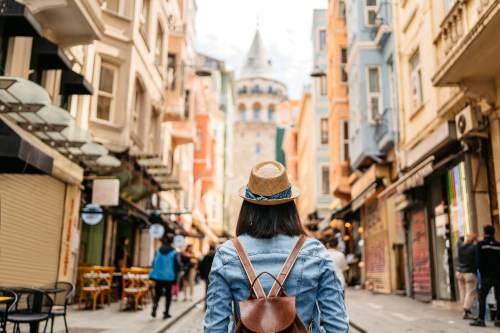When Paige More had a preventative double mastectomy at 24, the main thing on her mind was survival. She’d recently discovered that she had the BRCA1 gene mutation, which meant she faced an 87 percent risk of developing breast cancer—a disease that had taken several of her close family members. Put simply, she was terrified. So when the time came to meet with a plastic surgeon and talk breast reconstruction, her emotions were running so high that there were a lot of questions she didn’t even think to ask.
“I went into my surgeon and they said, ‘This is what we’re going to do.’ They presented it to me like it was my only option,” says More, a women’s health activist and co-founder of breast cancer support community The Breasties. She ended up having breast implants placed below her chest muscles—a common procedure for post-mastectomy patients—but wasn’t aware of how much physical discomfort they would end up causing her, especially during workouts. “I went into it thinking I would have perfect foobs [Breastie shorthand for “fake boobs”], and that’s just not the case,” she says. “I still have a lot of moments where it’s painful to move a certain way, and I can’t do certain workouts because my implants are too far apart.”
To be fair, research shows that disappointment over breast reconstruction is rare—most women under 60 who have undergone the process are just as satisfied with their breasts post-reconstruction as they were before the surgery. But there are still many surprises that can come up during the process, and experts agree that it’s important to gather as much information as possible before undergoing such a major procedure.
“The amount of counseling that a woman typically receives before undergoing breast reconstruction varies drastically from doctor to doctor,” says Constance M. Chen, MD, a board-certified plastic surgeon and breast reconstruction specialist. Many doctors are overbooked and don’t have time to spend more than a few minutes with each patient, while others simply aren’t comfortable with extensive patient counseling, she says. Plus, there are more options available for post-mastectomy breast reconstruction than ever before, which makes pre-op education even more challenging. Here’s an inside look at everything breast cancer patients have to take into consideration when thinking about reconstructive surgery after a mastectomy.
Understanding the reconstruction options
According to Mark Smith, MD, system vice chair of the department of surgery and director of reconstructive oncology for the Cancer Institute at Northwell Health, there are two main classes of post-mastectomy breast reconstruction. The first is breast implants, and the second is surgery that reconstructs breasts utilizing tissue from other parts of the patient’s body.
If a person goes for implants, that involves a whole additional set of decisions. “Every type of implant has pros and cons,” says Dr. Chen. “Silicone implants are softer and feel more natural, but they are much more problematic if they rupture. Saline implants are more firm and can feel less natural, but since they are filled with saline they tend to be less problematic if they rupture.” She adds that both types are made with a silicone shell. Studies suggest that neither category of implant is linked to adverse health outcomes like breast cancer, reproductive problems, or connective tissue disease, but the FDA says more research needs to be done before any definitive statements can be made.
Implant placement also has to be considered. Dr. Chen says that traditionally, the implant is placed below the muscle for an extra layer of protection. It’s often the go-to option for those at risk of skin breakdown [where parts of the skin get infected and even dies due to poor blood flow], including smokers or patients undergoing radiation. But it’s not always the ideal choice from the patient’s perspective. “Placing implants above the muscle is significantly more comfortable,” she says. Dr. Smith adds that recent advances have made above-the-muscle implants a more feasible and natural-looking option. These innovations include fat-grafting techniques to camouflage the implant and a type of dermal matrix that holds it in place.
But given that implants run the risk of rupture and generally need to be replaced during a person’s lifetime, some patients prefer to opt for tissue-based reconstruction—a more permanent solution. “This basically involves taking tissue from another part of the body and using it to reconstruct the breast,” says Dr. Smith. “Your own tissue is there forever and it’s a little more natural. If you gain weight it will get bigger, if you lose weight it will get smaller.” There are some limitations for this type of surgery as well—namely, a person must have enough tissue to transplant to their mastectomy site, and they have to deal with multiple post-op recovery zones. Even so, a recent study found that tissue-based reconstruction patients showed greater satisfaction with their breasts, psychosocial well-being, and sexual well-being after two years than those with implants.
Hybrid surgery is also an option—a combination of tissue-based reconstruction and an implant—as is no reconstruction at all. “I wish that someone had said ‘If you want to, you can stay flat,'” says More. “That was never presented to me. They just assumed that I’d have implants.”
Factored into the reconstruction equation: whether or not to keep one’s nipples. “Nipple preservation requires an oncological breast surgeon who is trained in nipple-sparing mastectomies,” says Dr. Chen. “More and more breast surgeons are capable of nipple preservation, but it is still uncommon.” A person’s particular diagnosis can also determine whether it’s even safe to keep their nipples. “If a patient has bloody nipple discharge or a large tumor close to the [nipple], then she is unlikely to be a candidate for nipple-sparing mastectomy for oncological reasons,” says Dr. Chen. Same thing for people who are smokers or have circulation issues, as there might not be adequate blood flow post-surgery to keep the nipple tissue alive and healthy.
Preparing for post-surgery life
Breast reconstruction is a major surgery, and experts say that many patients don’t realize how intense the recovery process can be. “Uncomplicated, uneventful wound healing in a healthy person takes about six to eight weeks on average,” says Dr. Chen. “You have to limit strenuous activity during that time, although we do encourage patients to walk and do range of motion exercises a week after surgery so they don’t get stiff,” adds Dr. Smith. “For some surgeries, it may be advisable to have a recliner to keep you from turning over if you’re a belly sleeper—or if your bedroom is on the top floor of a three-story house, you may want to set up a bed on the ground floor initially. There are things like going shopping for food and making sure that’s all available, and showers typically aren’t recommended until the wounds are healed.”
Most reconstruction surgeries go off without a hitch—but as with any medical procedure, there are risks. One study shows that close to a third of women who undergo breast reconstruction experience some kind of post-surgical complication. The severity of complications vary—some are simple infections that require an antibiotic—but in the aforementioned study, 19 percent of patients had a complication that required follow-up surgery, while 5 percent of patients had to remove the implant or tissue entirely. “Going into surgery, women should ask about best- and worse-case scenarios, and consider whether those scenarios are preferable to no surgery or going flat,” Dr. Chen says.
Of course, it’s also important to know what exactly one’s breasts will look like post-surgery. “No matter what, patients should be prepared for something that is different from how it was before,” says Dr. Chen. “If the patient has a traditional mastectomy and implant-based breast reconstruction, then they will have two mounds on their chest wall to replace their breasts, with horizontal scars across the mounds where the mastectomy was performed,” she says. “After a mastectomy, a woman has no breast tissue so the only thing covering what is inside her breast skin is the skin itself.” This means that any rippling or malpositioning of the implant will be more noticeable—and the implants will generally feel cold and numb to the touch. “I can be out in the sun sweating and my foobs will be cold,” says More. “In the winter it’s like ice packs on my chest.”
Tissue-based reconstructions, on the other hand, tend to look and feel more natural. “If someone has natural tissue breast reconstruction, then it will feel like natural tissue,” says Dr. Chen. “The breasts should be soft and warm, and if they have nerve reconstruction they may regain sensation as well.”
More also recommends talking to your doctor—or a mental health expert—about the emotional toll of a mastectomy and reconstruction. “You can feel physically strong and you can be mentally strong, but that doesn’t always translate to emotional strength,” she says. “I wasn’t someone who was that connected to my breasts, but the whole process was very intense. I’ve lost a lot of women in my family to breast cancer—and if you’re dealing with an actual cancer diagnosis, you’re fighting for your life. It’s a deeply emotional process.”
Breast cancer support groups (like The Breasties) are also a good option—in fact, More says that if the organization had been around when she had her mastectomy, her results might have turned out differently. “I had no one I could talk to about these things,” she says. “For anyone going through this, it’s so important to know you’re not alone.”
Here’s why another woman with the BRCA gene mutation is planning on having a preventative mastectomy. If you’re a woman of color, you may want to start getting breast-cancer screenings earlier than recommended—even if you don’t have high genetic risk.
Sign Up for Our Daily Newsletter
Get all the latest in wellness, trends, food, fitness, beauty, and more delivered right to your inbox.
Got it, you've been added to our email list.











